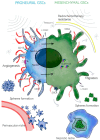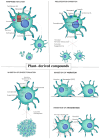Natural Compounds That Target Glioma Stem Cells
- PMID: 40559213
- PMCID: PMC12196138
- DOI: 10.3390/neurosci6020052
Natural Compounds That Target Glioma Stem Cells
Abstract
Gliomas are the most common central nervous system tumors and account for 30% of all primary brain tumors, 80% of all malignant ones, and the vast majority of deaths that are caused by brain tumors. Among them, glioblastoma multiforme has the most aggressive and invasive course. Due to its heterogeneity, it is difficult to treat, and one of the reasons for this are glioma stem cells (GSCs). Therapies such as radiotherapy and chemotherapy are used to treat gliomas but do not bring the expected results. Therefore, treatments targeting glioma stem cells are emerging. A promising strategy is to target GSCs with natural compounds. This review aims to describe the problem of glioma stem cells, the treatment of gliomas, and therapies based on natural compounds, which are promising for the future.
Keywords: glioblastoma; glioma stem cells; glioma treatment; natural compounds.
Conflict of interest statement
The authors declare no conflicts of interest.
Figures
References
Publication types
LinkOut - more resources
Full Text Sources



